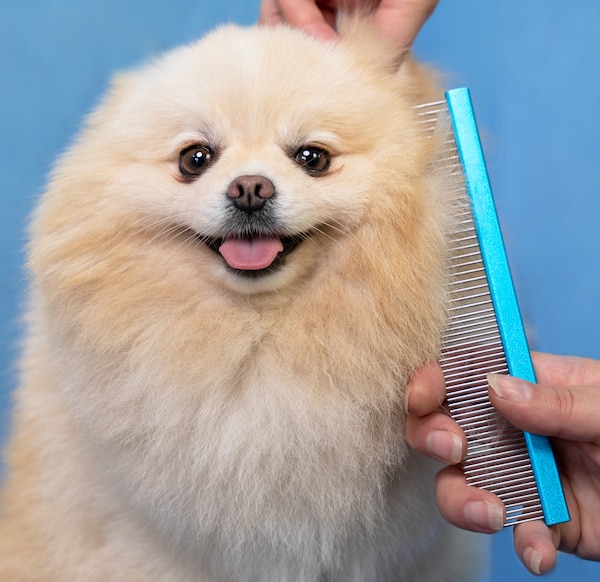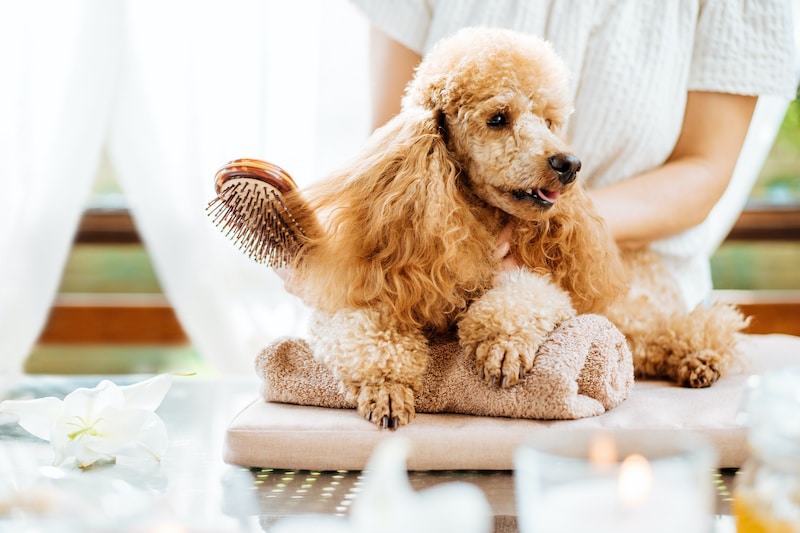With so many brushes out there, and all sorts of different brands, knowing which brush you should buy for your dog can be confusing at the best of times.
But it’s important to get this right in order to keep your dog’s coat healthy and in top shape. It’s also important if you want to keep shedding to a minimum, which you probably do.
That’s why we decided to put this article together, which breaks down the different types of brushes you can use for grooming and de-shedding. After reading this, you’ll be a pro and know exactly which brush is right for your dog and when it’s best to use it!
Types of Dog Grooming Brushes
There are four main types of brushes you can use for grooming and de-shedding your dog:
Depending on the type of coat your dog has, among other factors, you could get away with using just one type of brush, or you may need to use multiple.
For example, if you have a Bulldog, German Shorthaired Pointer, or Fox Terrier, a regular bristle brush will do the trick. But if you have a dog with a more extravagant coat, like an Afghan Hound or Tibetan Terrier, you may need some extra firepower!
My point is that each dog is unique. So it’s important to understand what type of coat your dog has in order to make the right decision. Generally speaking, longer, thicker, double-coated breeds require more attention than shorter, single-coated breeds.
Now let’s take a closer look at each type of brush.
1. Brushes
This is the most common tool people think to use when it comes to grooming their dog. There are several different kinds of brushes, though, and it pays to know what each is designed to do.
Pin Brush
The pin brush is a very common all round brush when it comes to getting out minor mats and tangles from medium-to-long-haired dogs. They have rubber or plastic tips on them and are gentle on thick or curly coats, which is why many use these as a first resort for minor knots and mats. They are generally quite kind to your dog’s skin and are safe to use on most breeds.

Bristle Brush
As you can see in the illustration, the bristle brush is often come combined with a pin brush because the two brush types go hand in hand. These are perfect for shorter coat dogs and are great for ‘finishing off’ since they remove fine dirt and add shine to the coat.
Regularly brushing with a bristle brush can increase the oil production in your dog’s skin, which can help to reduce excessive shedding and improve your dog’s overall coat shine. So these are always good to have on hand, no matter what type of dog you have.
Tip: Choose a bristle brush that matches the length and texture of your dog’s coat. For example, longer, softer bristles work better for silky long-haired dogs, while shorter, tougher bristles work better for shorter-haired dogs.
Rubber Brush
A rubber brush is an easy and cost-effective way to remove loose surface hair, as well as massage your pup’s skin. While some dogs love being brushed, some can’t stand it, so these can be a great alternative to a bristle brush for dogs that simply hate being brushed!
They are about the size of your hand and have rounded rubber knobs on the end. Some come in a glove format, while others look more like a rubber block. And they are sometimes referred to as a ‘curry comb.’ The main consistent feature is they’re a rubber brush.

Slicker Brush
The Slicker brush is a very common brush and is typically used on medium to long-haired dogs for removing mats and tangles and loose hair from the undercoat. They are made up of fine wire bristles, which are normally angled in a certain way and/or have protective tips to reduce irritation to your dog’s skin. They tend to work great, but it pays to be careful with how much pressure you apply, and it pays to brush with the direction of the coat.

2. Combs
There are several types of combs to choose from. Some are more useful for general grooming, others are better for removing mats and tangles, and some will even help to fend off fleas.
General Grooming Combs
These are kind of like the ‘comb version’ of the pin brush and are used for longer, thicker-haired dogs and those with an undercoat to help with knots and tangles.
The length and spacing of the teeth vary depending on the brush, and which one is right will depend on your dog and what you are trying to achieve.
As a general rule, wider-spaced teeth are better for removing knots and tangles, while more tightly-spaced teeth can be used after the main knots are removed. As you can see with the comb pictured below, it has both styles in one to make life easier.

De-matting Comb
These are useful for removing mats in long-haired dogs with heavy, thick coats. Rather than tearing or ripping the fur, it actually cuts out the mats.
Some groomers don’t recommend these and say they are too harsh, although used correctly and on the right coat type, they will get the job done. It may be worth checking with your local vet or grooming professional before buying one of these if you have concerns.
Flea Combs
Instead of relying solely on chemicals, these combs can make a world of difference when it comes to identifying and removing those nasty little fleas.
They consist of tightly spaced teeth that catch fine dirt and fleas in one motion to remove fleas naturally. You can also use these after treating your dog to eliminate as many fleas as possible before they jump onto the carpet, only to re-infest him later.

Tip: It’s important to work in the natural direction of your dog’s coat when using brushes, combs, and rakes to avoid unnecessary ripping or tearing of her fur. This matters because it can lead to skin irritation and discomfort, as well as excessive shedding.
3. Rakes
There are a number of different types of rakes you can use to groom and de-shed your dog, but you really only need to understand the following two types of rakes.
Standard Rakes
These look a bit like a miniature version of a standard garden rake. They have rounded ends to avoid causing irritation and are designed to remove dead fur from your dog’s coat. These are more suited to longer-haired dogs and can work to gently remove knots and tangles.

The above image looks more like a comb because that’s the best image I could find, but it shows you that the teeth are much wider spread apart than a regular comb.
Undercoat Rakes
Not all breeds have an undercoat, but for those that do, these work very well to remove mats, tangles, and loose fur from the undercoat. Especially for thick, long, and heavy-coated dogs.
Undercoat rakes have small, curved, and sharp blades on the end that work through mats and tangles with ease while effectively removing loose fur from your dog’s undercoat. The blades are located inside the curve at the very end, which means they won’t irritate your dog’s skin.
They will cut the coat to some extent where mats appear, but generally not as much as a de-matting comb does. Either way, they work well and are very safe to use.

4. De-Shedding Tools
If you have a dog that sheds and you are sick and tired of all that fluff and hair throughout your home, these are considered the holy grail of all shedding tools. They remove loose fur from the topcoat while penetrating the undercoat to remove dead fur in one smooth motion.
If you are concerned about shedding, these are well worth looking into. There are several well-known brands to choose from that work well, but our favorite is the Furminator. These look a bit like a razor, with one row of tightly spaced pins, and they work well on most coat types.

Tip: Most quality de-shedders come in a variety of sizes designed to match your dog’s coat and body type. And choosing the right one can make a big difference in how easy it is to use and how effectively the tool removes loose fur. Not to mention, choosing the right size will make grooming a more pleasant experience for your dog!
Bottom Line
There are many types of brushes out there, but as we’ve shown you in this article, they mostly fit into four main categories: regular brushes, combs, rakes, and de-shedding tools.
Which type of brush you use really depends on your dog’s coat.
A basic bristle/ pin brush combo will suit most dogs for everyday brushing. But when it comes to dogs with heavier, thicker coats and those with an undercoat, you may want to grab a slicker brush or an undercoat rake. Especially if you are trying to remove mats or tangles.
On the other hand, if shedding is your primary concern, it may be worth investing in a quality de-shedding tool like the Furminator or a similar generic brand if the price is a concern.
We’ve actually reviewed and put together a list of our top-rated de-shedding brushes, which you may find helpful if you want to compare what is currently available in the market.
You might also want to check out our dog hair blower reviews, as these handy tools can help you remove a lot more loose hair than brushing alone.
Whatever you decide, we hope this article has given you some worthwhile insight into the different types of brushes you can use to keep your dog’s coat in top shape!












Please note: By submitting a comment using the above comment form, you confirm that you agree with the storage and handling of your data by this site as detailed in our Privacy Policy.